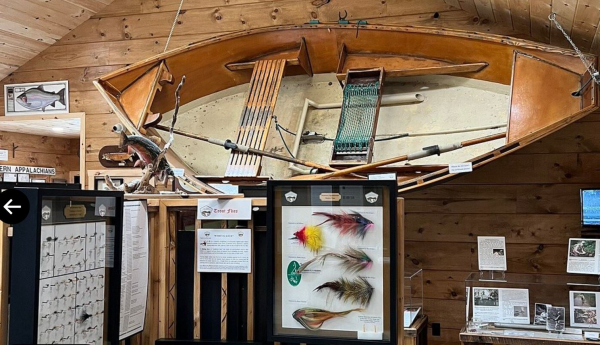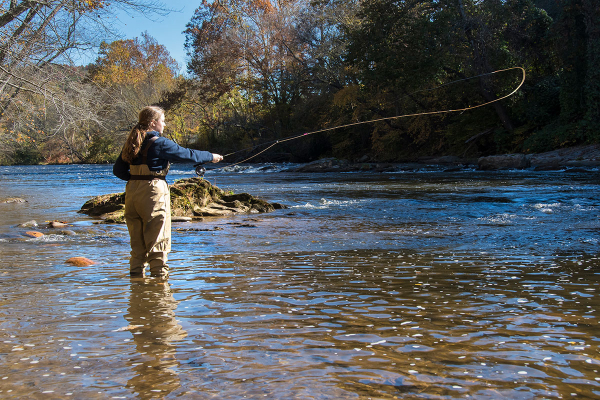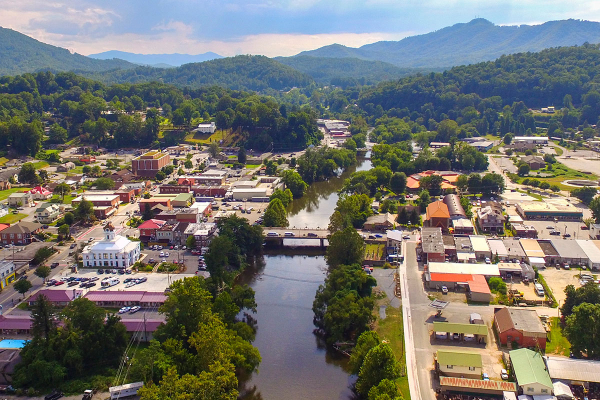
Those of us who fly fish are mostly about in-the-moment stuff, the latest rods and lines and new ways to tie Mylar, whatever we hope will help us fool fish with the improbable bits of fur and feather and whatnot we are compelled to put in front of them.
But a visit I made by accident to the Fly Fishing Museum of the Southern Appalachians in Bryson City, NC, last week reminded me that we are part of a long tradition, and that we stand on the shoulders of some dedicated anglers who have shaped the sport for decades—and centuries.
The museum sits a short cast from the Tuckasegee River right in the heart of Bryson City, which among its other accolades is also boyhood hometown of noted outdoors author and college professor Jim Casada.
The museum is self-guided, but staff are available to answer questions about the history, the exhibits, or to help you learn more about the fishing regulations in the area.
Some of the historic gear used in fly fishing will be of interest to most, as well as the full-sized Mackenzie drift boat and some of the historic flies, including muskie flies the size of a muskrat. (Try flinging one of those on your 5-weight!) There is no admission fee to enter the facility, but donations are welcomed (and needed). Visit the Appalachian Rivers Aquarium next door, also free, to see live trout, smallmouth, largies, catfish, panfish, etc. Learn more at https://www.explorebrysoncity.com/fly-fishing-capital-of-the-south/fly-fishing-museum.

Fishing the Tuckasegee
The Tuck’ is loaded with stocked rainbows and browns. You can wade the shores of the river in many places, though a kayak or SUP would make things a lot easier. There are guides who will take you to the prime spots via drift boat (when the flow is adequate), which is the best way to assure some quality fishing if you can spend the money.
Some of the best flies, locals tell me, are the elk hair caddis in size 8-16 for a floater, any sort of bead-eye nymph in sizes 12 to 18, and the revered Wooly Booger in sizes 2-6 for streamers. Some use the caddis on top and a nymph on a dropper, with the caddis acting as both an attractor and a strike indicator for the nymph. (If you’re not a fly fisher, no problem—a salmon egg under a small float or a small rooster-tail spinner will catch ‘em just as well.)
The trout fishing is mostly upriver from Bryson City—just below town, it flows into Lake Fontana. The area from Dillsboro downstream is heavily stocked, and any riffle or deep pool is likely to be productive.

The most popular reach of the river is the upper delayed harvest section that starts in Webster at the lowest NC 107 crossing and continues down to the old dam site in Dillsboro. There are several parking pull-offs and options on North River Road, (Highway 1359). The river is mostly flat water but has a few bumpy stretches and drops that can flip an inexperienced paddler, so if you go by kayak or canoe keep an eye out. Sometimes the flow is so low that you may have to portage in some areas. There’s endless highway access some 30 miles upriver to the town of Tuckasegee, named for the location where two smaller rivers form the main Tuckasegee.
While you’re in the area, if you enjoy wildlife watching, take a drive up through the village of Cherokee into the lower end of Smoky Mountain National Park to check out the elk herd in the meadows around the Oconaluftee Visitors Center—they’re out there mornings and evenings on most fall days, anywhere from a lone bull or two to a mixed herd of 50 or more. You’re also likely to see wild turkeys in the area, particularly during strutting time in March and early April.
This area is also a good spot to hop on the Blue Ridge Parkway and follow it down to the exit near Silva for some of the best mountaintop views in the Smokies.
Avoid the 431 drive through the park during high traffic periods (now, due to prime leaf color) and particularly avoid Gatlinburg and Pigeon Forge, which are basically four-lane traffic jams surrounded by over-priced attractions and way over-priced restaurants.
By Frank Sargeant
Frankmako1@gmail.com